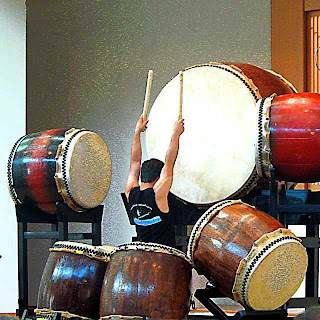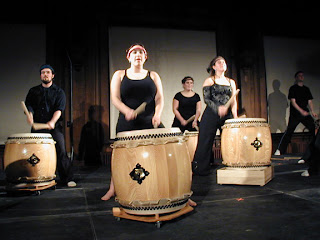The word taiko (太 鼓) means "big drum" in Japanese. Outside Japan, the word is used to refer to various types of Japanese drum (和 太 鼓, 'Wa-Daiko', "Japanese drum", in Japanese) and to the art form is relatively recent in the form of ensemble drumming (sometimes more special called, "kumi-Daiko" (组 太 鼓).
Nagado-Daiko (长 胴 太 鼓, long-bodied taiko) consists of two pieces of cow skin stretched over a wooden frame (usually carved from one piece of wood, are now often made from the remains of a wooden barrel) and stretched. Head of tsukeshime-Daiko (付 締め 太鼓, often shortened to, "shime-Daiko" or "shime" only) spread over iron rings and clamped around a smaller body. Tsukeshime-Daiko rope is pulled up tight before use each time. Okedo-Daiko (桶 胴 太 鼓, taiko-bodied barrel-shaped, often shortened to "okedo" or "okay") can be mounted on a stand and played like a taiko other, but usually hung across the shoulder so the drummer can walk and also play it. Taiko Japanese Other includes uchiwa-Daiko (内 轮 太 鼓, taiko fan), hira-Daiko (平 太 鼓, taiko flat), o-Daiko (大 太 鼓, taiko great), and a series of instruments of percussion others in the ensemble of traditional Japanese noh, Gagaku, and kabuki.
Okedo-Daiko drum ranged from small and portable, to the greatest drummer of all Japanese drum. In contrast to nagado, these drums can be made in various sizes, but not in any given size of timber construction stavenya. Aomori region is famous for the festival Nebuta. Here the large okedo played by many people as he was taken by train along the way. Okedo cantilever has its own betta created by Hayashi Eitetsu.
In addition, as nagado-Daiko, okedo have sound edges, called "ka." However, when playing the rim of a okedo, it is important for players to hit the only part that Palin outside of the ring metal and not the periphery of the drum body itself. Thinner and lighter than wood okedo particularly easy to dent and will quickly deteriorate if hit.
The use of taiko in warfare
In Japan in feudal times, taiko is often used to motivate troops, to help determine the step sequence, and adjust orders or announcements. Toward or at the time of entering the battle, the taiko Yaku (drummer) is responsible for determining the step sequence, usually with six steps for each drum hit (knock-2-3-4-5-6, a knock-2-3-4-5 -6).
According to one historical record (Gunji Yoshu), nine cluster of five beats meant to call allies into battle, while the nine cluster of three beats, precipitated three or four times, is a call to come forward and pursue your opponent.
Bachi
wooden paddle used to play taiko drums.
Ji
Jiuchi also called, is a basic rhythm that is used to support the main rhythm, or O-uchi. Some of the more common rhythms for ji are don doko, don ko, or don go (swing pattern). Jikata is a player who plays rhythm ji.
Oroshi
characterized by a series of blows on the taiko. Players start slowly with a lot of ma. Slowly ma (time) between each blow is becoming increasingly shorter, until the musicians do a quick blow
Shamisen or samisen (三味 线, Shamisen or samisen?) Is a Japanese stringed musical instrument with three strings, and plucked using a type of pick is called a bachi.
In the world of Japanese music of the modern age (Kinsei hōgaku) such genre jiuta and sōkyoku (sankyoku), shamisen known as san-gen (三弦, 三弦, san-gen? Three strings), while in the area of Okinawa known as Sanshin (三 线, Sanshin ?).
Form
Agency shamisen (called do) is made of wood, shaped rectangular with four corners of a slightly curved. The front and back covered with animal skin that serves amplifies the sound from the strings. Leather upholstery is the skin of the abdomen shamisen female cat who has never married. While the usual quality shamisen is made from the skin of the back of the dog. Shamisen are made of imitation leather has a nice sound quality is not making it less popular.
The length of the shamisen is similar to the guitar but the neck (sao) is more slender and without frets. There shamisen neck that consists of 3 parts to be easily carried around and stored. Shamisen neck that can not be removed intact and-off called nobezao neck.
Silk is the raw material for stringed shamisen. Tsugaru-jamisen originating from Tsugaru region there who wore strings of nylon fibers or tetoron. The strings in sequence from left to right (from the thickest string) is called the ichi no ito (first string), ni no ito (second string), and san no ito (third string).
Type
Broadly speaking, the shamisen consists of three types based on the size of the neck: Hosozao (narrow neck), Nakazao (neck medium), and Futozao (large neck). In addition, the type of shamisen grouped by the name of art:
* Nagauta shamisen, slender-necked, plucked with a pick of elephant ivory, and used in kabuki performances
* Gidayū shamisen, a large and thick-necked, and used as an accompaniment jōruri
* Tokiwazu-Bushi shamisen, necked being
* Kiyomoto shamisen, being necked.
* Jiuta shamisen, are necked, plucked with a pick is called Tsuyamabachi of elephant ivory material. This type is often called the shamisen sankyoku, played with koto, kokyu, and shakuhachi.
* Shinnai shamisen, are necked, plucked with the finger nail.
* Yanagawa shamisen (Kyo-shamisen), more slender than Hosozao necked, shamisen is the oldest model
* Tsugaru-jamisen, width and thick-necked, used to track an area called Tsugaru-minyō, bachi, and learned to use smaller and made of tortoise shell.
* Shanshin origin of the Ryukyu Islands, was used in the prefecture of Okinawa and the very tip of Kagoshima prefecture. Shanshin made from python skins from Indonesia, neck shamisen lacquered with Urushi, and learned not to use bachi, but with a pick from buffalo horn.
* Gottan, from Kagoshima Prefecture, made entirely of wood and do not wear animal skins.
History
In the classification of musical instruments, including the shamisen lute stringed instrument similar to the neck (neck) is connected to the body. Around the world there are many diversified musical instruments like the lute, ranging from guitar, zither, ukulele up. Ancient Egyptian Culture three stringed stringed instrument known in Persia developed into setaru or sitar ("se" means "three" and "taru" meaning "strings"). In China, a similar instrument zither made with snakeskin upholstery called sanshen (sanxian). Trade between the Kingdom of Ryukyu and Fuzhou sanshen introduce instruments that later in Okinawa called the Sanshin.
At the end of the 16th century, merchant ships carried Sanshin origin introduced to the Ryukyu Sakai city dwellers. Shamisen oldest extant today is called Yodo shamisen craftsmen works in Kyoto. Shamisen is specially made by order of Toyotomi Hideyoshi to be presented to his wife Yodo-dono. Yodo shamisen has a form that is not much different from the existing shamisen.
Sanshin developments of foreign origin into the shamisen can not be separated from the role of blind musicians blind Tōdōza origin association. Sanshin is played with a pick-shaped nails from buffalo horn evolved into a shamisen is plucked with a bachi are used to picking a musical instrument biwa. Shamisen a more crisp sound was more unpopular than the person who impressed biwa sound heavy and serious.
One of the blind musician named Ishimura Kengyō meritorious develop techniques to play the shamisen popular masses. At the beginning of the Edo period, Ishimura Kengyō pioneered the use of shamisen music genres and is known as jiuta. Broadly speaking shamisen music is divided into two types, Utaimono (counterpoint) and Katarimono (accompaniment story).
imi Ga Yo (Japanese: 君が代 is the title of the Japanese national anthem.
The song was written in a Japanese waka metrum. Some argue that the song actually love poetry.





{ 0 comments... read them below or add one }
Post a Comment